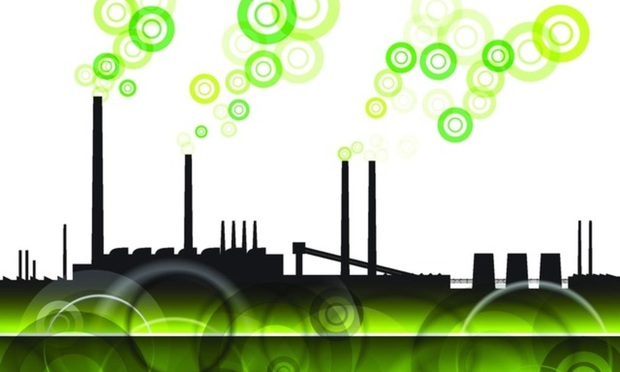Why Do We Need the Green Amendment?
New Yorkers do not presently have a right to clean air and water.
March 15, 2021 at 08:48 AM
4 minute read
 This fall, New Yorkers will be asked to vote on whether the New York State Constitution should be amended to recognize a "a right to clean air and water, and a healthful environment." I suspect that, for many, this will cause a bit of head scratching. You mean we don't already have a right clean air and water?
This fall, New Yorkers will be asked to vote on whether the New York State Constitution should be amended to recognize a "a right to clean air and water, and a healthful environment." I suspect that, for many, this will cause a bit of head scratching. You mean we don't already have a right clean air and water?
No, New Yorkers do not presently have a right to clean air and water. There are many laws aimed at protecting human health and the environment, including laws designed to ensure that our drinking water is safe to drink and that our air is safe to breathe. But, as any resident of Hoosick Falls can tell you, if, for some reason, those laws don't apply or aren't being implemented effectively, citizens may have little recourse.
In the case of Hoosick Falls, a citizen concerned about an unusual number of family and neighbors getting cancer paid to have his drinking water tested, which revealed high levels of perfluorooctanoic acid (PFOA), a suspected carcinogen. Upon reporting the high levels of PFOA in the water to the relevant regulators, the Village of Hoosick Falls was assured by the Rensselaer County Department of Health and New York State Department of Health that Hoosick Falls' drinking water met all relevant standards and was safe to drink, going so far as to advise the Village that it was not necessary to collect more water samples. But here's the catch about PFOAS as well as many other so-called emerging contaminants, like 1, 4 dioxane (also regularly found in drinking water in New York). The laws designed to keep our drinking water safe only limit chemicals in drinking water for which drinking water standards have been established. If a standard hasn't been set (a process that can take decades), the chemical can lawfully remain in our drinking water. And, although serious concerns have been raised for decades about health risks from exposure to PFOA and similar chemicals, no national drinking water standard for it has yet been developed (although New York set its own standard of 10 parts per trillion in August 2020).
This content has been archived. It is available through our partners, LexisNexis® and Bloomberg Law.
To view this content, please continue to their sites.
Not a Lexis Subscriber?
Subscribe Now
Not a Bloomberg Law Subscriber?
Subscribe Now
NOT FOR REPRINT
© 2025 ALM Global, LLC, All Rights Reserved. Request academic re-use from www.copyright.com. All other uses, submit a request to [email protected]. For more information visit Asset & Logo Licensing.
You Might Like
View All
The Public Is Best Served by an Ethics Commission That Is Not Dominated by the People It Oversees
4 minute read
The Crisis of Incarcerated Transgender People: A Call to Action for the Judiciary, Prosecutors, and Defense Counsel
5 minute readTrending Stories
- 1Law Firms Expand Scope of Immigration Expertise, Amid Blitz of Trump Orders
- 2Latest Boutique Combination in Florida Continues Am Law 200 Merger Activity
- 3Sarno da Costa D’Aniello Maceri LLC Announces Addition of New Office in Eatontown, NJ, and Named Partner
- 4Friday Newspaper
- 5Public Notices/Calendars
Who Got The Work
J. Brugh Lower of Gibbons has entered an appearance for industrial equipment supplier Devco Corporation in a pending trademark infringement lawsuit. The suit, accusing the defendant of selling knock-off Graco products, was filed Dec. 18 in New Jersey District Court by Rivkin Radler on behalf of Graco Inc. and Graco Minnesota. The case, assigned to U.S. District Judge Zahid N. Quraishi, is 3:24-cv-11294, Graco Inc. et al v. Devco Corporation.
Who Got The Work
Rebecca Maller-Stein and Kent A. Yalowitz of Arnold & Porter Kaye Scholer have entered their appearances for Hanaco Venture Capital and its executives, Lior Prosor and David Frankel, in a pending securities lawsuit. The action, filed on Dec. 24 in New York Southern District Court by Zell, Aron & Co. on behalf of Goldeneye Advisors, accuses the defendants of negligently and fraudulently managing the plaintiff's $1 million investment. The case, assigned to U.S. District Judge Vernon S. Broderick, is 1:24-cv-09918, Goldeneye Advisors, LLC v. Hanaco Venture Capital, Ltd. et al.
Who Got The Work
Attorneys from A&O Shearman has stepped in as defense counsel for Toronto-Dominion Bank and other defendants in a pending securities class action. The suit, filed Dec. 11 in New York Southern District Court by Bleichmar Fonti & Auld, accuses the defendants of concealing the bank's 'pervasive' deficiencies in regards to its compliance with the Bank Secrecy Act and the quality of its anti-money laundering controls. The case, assigned to U.S. District Judge Arun Subramanian, is 1:24-cv-09445, Gonzalez v. The Toronto-Dominion Bank et al.
Who Got The Work
Crown Castle International, a Pennsylvania company providing shared communications infrastructure, has turned to Luke D. Wolf of Gordon Rees Scully Mansukhani to fend off a pending breach-of-contract lawsuit. The court action, filed Nov. 25 in Michigan Eastern District Court by Hooper Hathaway PC on behalf of The Town Residences LLC, accuses Crown Castle of failing to transfer approximately $30,000 in utility payments from T-Mobile in breach of a roof-top lease and assignment agreement. The case, assigned to U.S. District Judge Susan K. Declercq, is 2:24-cv-13131, The Town Residences LLC v. T-Mobile US, Inc. et al.
Who Got The Work
Wilfred P. Coronato and Daniel M. Schwartz of McCarter & English have stepped in as defense counsel to Electrolux Home Products Inc. in a pending product liability lawsuit. The court action, filed Nov. 26 in New York Eastern District Court by Poulos Lopiccolo PC and Nagel Rice LLP on behalf of David Stern, alleges that the defendant's refrigerators’ drawers and shelving repeatedly break and fall apart within months after purchase. The case, assigned to U.S. District Judge Joan M. Azrack, is 2:24-cv-08204, Stern v. Electrolux Home Products, Inc.
Featured Firms
Law Offices of Gary Martin Hays & Associates, P.C.
(470) 294-1674
Law Offices of Mark E. Salomone
(857) 444-6468
Smith & Hassler
(713) 739-1250








